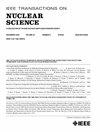Low-Energy X-Ray Polarization Detector Detection Unit Prototype
IF 1.9
3区 工程技术
Q3 ENGINEERING, ELECTRICAL & ELECTRONIC
引用次数: 0
Abstract
The low-energy X-ray polarization detector (LPD) is a large-area and wide-field-of-view (FoV) X-ray polarimeter planned to be installed on the China Space Station. The LPD is designed to measure the polarization of gamma bursts and their early X-ray afterglows, facilitating studies of celestial bodies and radiation mechanisms at the centers of gamma bursts. The LPD consists of 15 detection units with identical structure and function. A detection unit prototype was developed, featuring six pixel detectors compactly placed on a bonding and front-end electronics (BFE) board with an effective detection area of低能x射线偏振探测器探测单元样机
低能x射线偏振探测器(LPD)是计划安装在中国空间站上的一种大面积、宽视场(FoV) x射线偏振计。LPD旨在测量伽马暴及其早期x射线余辉的极化,促进伽玛暴中心天体和辐射机制的研究。LPD由15个结构和功能相同的检测单元组成。开发了一个检测单元原型,将六个像素探测器紧凑地放置在键合和前端电子(BFE)板上,有效检测面积为27.36~\rm cm^{2}$。每个像素检测器有16个模拟输出通道,之后数据被放大、数字化,并通过板对板(BTB)连接器传输到数据采集(DAQ)板进行处理。该原型还包括一个内部高压电路,电压高达- 4千伏。测试结果表明,该检测单元样机可同时读取96路像素探测器的数据,等效电荷噪声为49.49 e $^{-}$。它具有全面的电源管理,提供可配置的数据压缩,存储和编码,并满足检测单元的所有功能要求。
本文章由计算机程序翻译,如有差异,请以英文原文为准。
求助全文
约1分钟内获得全文
求助全文
来源期刊

IEEE Transactions on Nuclear Science
工程技术-工程:电子与电气
CiteScore
3.70
自引率
27.80%
发文量
314
审稿时长
6.2 months
期刊介绍:
The IEEE Transactions on Nuclear Science is a publication of the IEEE Nuclear and Plasma Sciences Society. It is viewed as the primary source of technical information in many of the areas it covers. As judged by JCR impact factor, TNS consistently ranks in the top five journals in the category of Nuclear Science & Technology. It has one of the higher immediacy indices, indicating that the information it publishes is viewed as timely, and has a relatively long citation half-life, indicating that the published information also is viewed as valuable for a number of years.
The IEEE Transactions on Nuclear Science is published bimonthly. Its scope includes all aspects of the theory and application of nuclear science and engineering. It focuses on instrumentation for the detection and measurement of ionizing radiation; particle accelerators and their controls; nuclear medicine and its application; effects of radiation on materials, components, and systems; reactor instrumentation and controls; and measurement of radiation in space.
 求助内容:
求助内容: 应助结果提醒方式:
应助结果提醒方式:


